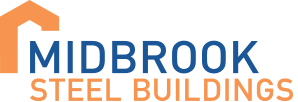When embarking on the journey of constructing a commercial building, one of the most crucial decisions to make is selecting the appropriate building material. The choice is influenced by a myriad of factors, including the building’s intended purpose, location, budget constraints and design preferences. Commercial buildings come in various forms, from towering office complexes to sprawling warehouses and inviting restaurants. In this article, we explore some of the most common materials used in commercial construction in the UK and rate them across several key factors to help you make an informed decision.
1. Steel: The Backbone of Commercial Construction
Steel stands tall as a favoured choice for commercial buildings, particularly for structural framing. Its attributes include impressive strength, durability and remarkable versatility. Steel buildings often find their place in office buildings, expansive warehouses, retail spaces and industrial facilities. Notably, steel also boasts affordability and swift construction turnaround times, complemented by an array of available cladding options.
Rating
– Cost-effectiveness: 8/10
– Durability and Longevity: 9/10
– Turnaround Time Speed: 9/10
– Sustainability/Environmental Impact: 7.5/10
2. Concrete: The Solid Foundation
Concrete is another prevalent material in UK commercial construction. It serves as the foundation, walls and flooring of many commercial structures. As concrete can have a longer turnaround time, precast concrete panels and tilt-up construction methods can be used to accelerate the construction process.
Rating
– Cost-effectiveness: 7/10
– Durability and Longevity: 9/10
– Turnaround Time: 6/10
– Sustainability/Environmental Impact: 5/10
3. Brick and Masonry: A Timeless Classic
Brick and masonry materials remain staples for the exterior walls of commercial buildings. They lend a sense of durability and timeless aesthetics to the structure. When combined with other materials, they can create intriguing architectural designs.
Rating
– Cost: 6/10
– Durability and Longevity: 9.5/10
– Turnaround Time: 5/10
– Sustainability/Environmental Impact: 5.5/10
4. Wood: A Natural Contender
Wood, while less common in commercial construction compared to residential projects, finds its place in certain applications. It can be used for interior finishes, timber framing, timber cladding or as exposed structural elements in select designs.
Rating
– Cost-effectiveness: 8.5/10
– Durability and Longevity: 7/10
– Turnaround Time: 8.5/10
– Sustainability/Environmental Impact: 8/10
When selecting materials for your commercial building, it’s vital to consider factors such as the building’s intended use, energy efficiency goals, maintenance requirements, and adherence to local building codes. Collaborating with architects, engineers, and construction professionals experienced in commercial construction will help you make informed decisions tailored to your project’s unique needs.
If you’re leaning towards opting for a steel building or simply want to explore steel’s potential for your project further, feel free to reach out to Midbrook Steel Buildings for a no-obligation FREE quote. Our team of steel framed building experts is here to assist you in realising your commercial construction vision with the right materials and expertise.
*Please note that these ratings are averages from extensive research but are also approximate and can vary based on specific project details and choices made.


